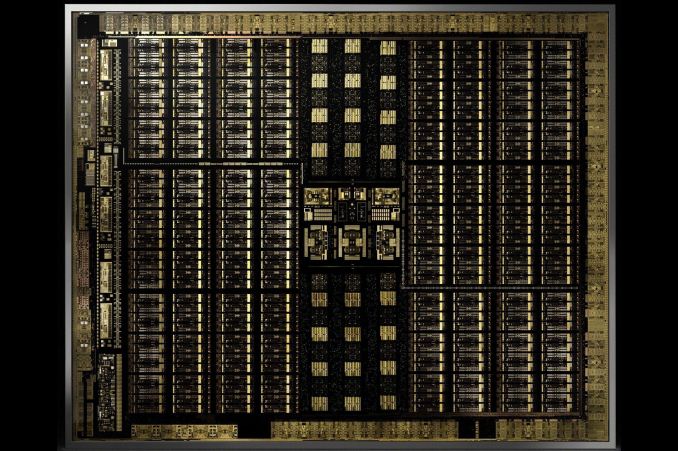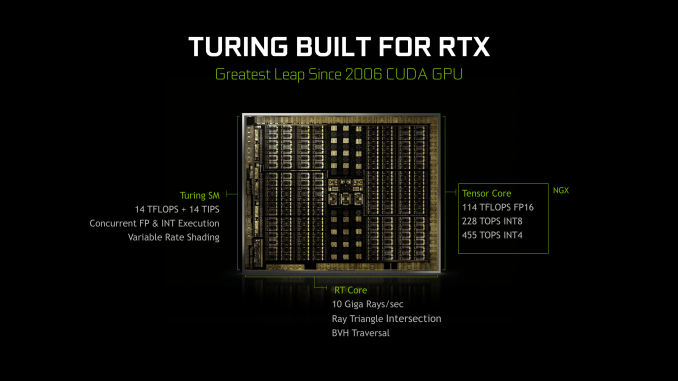The NVIDIA Turing GPU Architecture Deep Dive: Prelude to GeForce RTX
by Nate Oh on September 14, 2018 12:30 PM EST
It’s been roughly a month since NVIDIA's Turing architecture was revealed, and if the GeForce RTX 20-series announcement a few weeks ago has clued us in on anything, is that real time raytracing was important enough for NVIDIA to drop “GeForce GTX” for “GeForce RTX” and completely change the tenor of how they talk about gaming video cards. Since then, it’s become clear that Turing and the GeForce RTX 20-series have a lot of moving parts: RT Cores, real time raytracing, Tensor Cores, AI features (i.e. DLSS), raytracing APIs. All of it coming together for a future direction of both game development and GeForce cards.
In a significant departure from past launches, NVIDIA has broken up the embargos around the unveiling of their latest cards into two parts: architecture and performance. For the first part, today NVIDIA has finally lifted the veil on much of the Turing architecture details, and there are many. So many that there are some interesting aspects that have yet to be explained, and some that we’ll need to dig into alongside objective data. But it also gives us an opportunity to pick apart the namesake of GeForce RTX: raytracing.
While we can't discuss real-world performance until next week, for real time ray tracing it is almost a moot point. In short, there's no software to use with it right now. Accessing Turing's ray tracing features requires using the DirectX Raytracing (DXR) API, NVIDIA's OptiX engine, or the unreleased Vulkan ray tracing extensions. For use in video games, it essentially narrows down to just DXR, which has yet to be released to end-users.
The timing, however, is better than it seems. A year or so later could mean facing products that are competitive in traditional rasterization. And given NVIDIA's traditionally strong ecosystem with developers and middleware (e.g. GameWorks), they would want to leverage high-profile games for ringing up consumer support for hybrid rendering, which is where both ray tracing and rasterization is used.
So as we've said before, with hybrid rendering, NVIDIA is gunning for nothing less than a complete paradigm shift in consumer graphics and gaming GPUs. And insofar as real time ray tracing is the 'holy grail' of computer graphics, NVIDIA has plenty of other potential motivations beyond graphical purism. Like all high-performance silicon design firms, NVIDIA is feeling the pressure of the slow death of Moore's Law, of which fixed function but versatile hardware provides a solution. And where NVIDIA compares the Turing 20-series to the Pascal 10-series, Turing has much more in common with Volta, being in the same generational compute family (sm_75 and sm_70), an interesting development as both NVIDIA and AMD have stated that GPU architecture will soon diverge into separate designs for gaming and compute. Not to mention that making a new standard out of hybrid rendering would hamper competitors from either catching up or joining the market.
But real time ray tracing being what it is, it was always a matter of time before it became feasible, either through NVIDIA or another company. DXR, for its part, doesn't specify the implementations for running its hardware accelerated layer. What adds to the complexity is the branding and marketing of the Turing-related GeForce RTX ecosystem, as well as the inclusion of Tensor Core accelerated features that are not inherently part of hybrid rendering, but is part of a GPU architecture that has now made its way to consumer GeForce.
For the time being though, the GeForce RTX cards are not released yet, and we can’t talk about any real-world data. Nevertheless, the context of hybrid rendering and real time ray tracing is central to Turing and to GeForce RTX, and it will remain so as DXR is eventually released and consumer-relevant testing methodology is established for it. In light of these factors, as well as Turing information we’ve yet to fully analyze, today we’ll focus on the Turing architecture and how it relates to real-time raytracing. And be sure to stay tuned for the performance review next week!












111 Comments
View All Comments
Alistair - Sunday, September 16, 2018 - link
Except for the GTX 780 was the worse nVidia release ever, at a terrible price. Nice try ignoring every other card in the last 10 years.markiz - Monday, September 17, 2018 - link
How can it be the same segment of the market, if the prices are, as you claim, double+?I mean, that claim makes no sense. It's not same segment. it's higher tier.
I mean, who is to say what kind of an advancement in GPU and games have people supposed to be getting?
Buy a 500$ card and max settings as far as they go and call it a day.
If you are
Ej24 - Monday, September 17, 2018 - link
The R&D for smaller manufacturing nodes hasn't scaled linearly. It's been almost exponential in terms of $/Sq.mm to develop each new node. That's why we need die shrinks to cram more transistors per square mm, and why some nodes were skipped because the economics didn't work out, like 20/22nm gpu's never existed. You're assuming that manufacturers have fixed costs that have never changed. The cost of a semiconductor fab, and R&D for new nodes has ballooned much much faster than inflation. That's why we've seen the number of fabs plummet with every new node. There used to be dozens of fabs in the 90nm days and before. Now it's looking like only 3 or 4 will be producing 7nm and below. It's just gotten too expensive for anyone to compete.milkod2001 - Tuesday, September 18, 2018 - link
All those ridiculous prices started when AMD have announced 7970 at $550 plus. NV had mid range card to compete with it: GTX 680 at the same price. And then NV Titan high end cards were introduced at $1000 plus. Since then we pay past high end prices for mid range cards.futrtrubl - Wednesday, September 19, 2018 - link
Just a bit on your math. You say $1 accounting for inflation of 2.7% over 18 years is now just less than $1.50. Maybe you are doing it as $1 * 18 * 1.027 to get that which is incorrect for inflation. It compounds, so it should be $1 * ( 1.027^18) which comes to ~$1.62. Likewise at 5% over 18 years it becomes $2.41.Da W - Sunday, September 16, 2018 - link
Since when does inflation work in the semiconductor industry?Holliday75 - Monday, September 17, 2018 - link
I was wondering the same thing. Smaller, faster, cheaper. For some reason here its the opposite....for 2 out of 3.Yojimbo - Saturday, September 15, 2018 - link
"You must literally live under a rock while also being absurdly naive.It's never been this way in the 20 years that i've been following GPUs. These new RTX GPUs are ridiculously expensive, way more than ever, and the prices will not be changing much at all when there's literally zero competition. The GPU space right now is worse than it's ever been before in history."
No, if you go back and look at historical GPU prices, adjusted for inflation, there have been other times that newly released graphics cards were either as expensive or more expensive. The 700 series is the most recent example of cards that were as expensive as the 20 series is.
eddman - Saturday, September 15, 2018 - link
No.https://i.imgur.com/ZZnTS5V.png
This chart was made last year based on 2017 dollar value, but it still applies. 20 series cards have the highest launch prices in the past 18 years by a large margin.
eddman - Saturday, September 15, 2018 - link
There is one card that surpasses that, 8800 Ultra. It was nothing more than a slightly OCed 8800 GTX. Nvidia simply released it to extract as much money as possible, and that was made possible because of lack of proper competition from ATI/AMD in that time period.